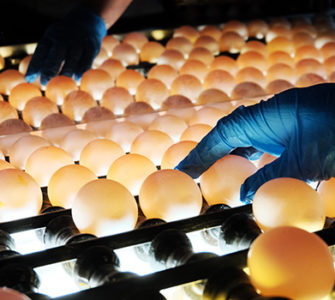Seasonal management in hatchery critical to improving chick viability
Optimizing hatchery conditions throughout the year is crucial to limiting chick mortality and maintaining long-term bird viability, according to a poultry health expert.
Hatchery consultant Chris Williams, PhD, said seasonal temperature changes outside the hatchery affect temperatures and air pressure inside.
And if managers don’t take steps to compensate for those changes, it can lead to increases in early mortality and reduce hatchability by as much as 3%.
Speaking to Poultry Health Today, Williams said that while only 100 in every 20,000 birds are affected by changes in the environment, those losses can add up.
Paying attention to detail from the moment eggs arrive at the hatchery, including storing eggs at the optimum temperature, is an important first step to reducing losses and giving chicks the best chance of survival.
“When eggs are stored too cold, they don’t start incubation uniformly or correctly,” he explained. “They’re delayed, and that delay stays with them the whole incubation period.”
Different temperatures within the incubator can also cause problems, with eggs in lower regions susceptible to evaporative cooling thanks to cool floor temperatures.
“A lot of that is alleviated with single stage,” he added. “But the majority of hatcheries in North America are multi-stage.”
Minimizing extremes
As a general rule, Williams said he likes to see temperatures of 78° F to 82° F in hallways, with a humidity of 50% to 60%.
“We don’t need to see cycling of that outside those parameters too long,” he added. “I would much prefer to see very short cycles rather than an extreme where we have a 20- or 25-minute cycle that spends most of its time out of the range.
“The extremes are really creating problems for the equipment [which is] trying to maintain an environment inside — it’s a box in a box.
“And so, the better we can do with the exterior box, the better the interior box does to maintain a homogeneous temperature.”
In terms of wider hatchery management, Williams said it’s important to understand that every hatchery has a unique environment which might require different airflows at certain times of year.
“Things like the clean room… In summer we push a lot of air through there because it’s hot, and we try to get a lot of the humidity out. In the winter, we restrict that air quite a bit because it’s cold outside.
“[So] following the bird through production, looking at the environment as they’re moving through and understanding that can be enlightening. A lot of the times it’s not a big adjustment; it’s just finding what the optimal [point] is.”
Attention to airflows
Getting airflows right can also bring another benefit, he added, as air is one of the best sanitizers available.
“When we don’t have the same airflow, we don’t have the same disinfection capabilities of the equipment in the hatcher. So, attention to detail and sanitation requires a higher level of attention in the winter because we don’t have that supplemental drying effect that air brings.”
With new hatcheries being built and existing facilities being upgraded, Williams said ventilation is improving across the industry. But he said it is still important to look at other factors which might compromise airflow.
“For example, we’ve added some incubation capacity, or hatching capacity, but we didn’t really address our egg storage,” he said.
“Probably our lowest hanging fruit is in our egg storage; we need to do a better job with quality control before the eggs are even set.”
Optimize egg storage
To improve conditions, Williams said an important step is to ensure eggs are put in the best environment within the storage room.
“Egg storage rooms tend to be shared spaces for empty farm racks or incubation racks. Don’t put those in the best place as far as temperature and airflow; put your eggs there.”
Internal biosecurity of the hatchery is also critical, especially as more and more of the industry moves to no-antibiotics-ever production, he added. Attention to detail, such as washing and drying chick boxes every day, is crucial.
“We need to have a clean division between when those birds are placed on the farm, and the next set of birds that goes through it,” he added.
The impact of vaccination of birds also needs to become a focus, particularly in terms of the chill effect that can occur following spray vaccination.
“That period of time of drying and vaccine uptakes needs to be closely monitored. We don’t need excessively wet birds going into our trucks. They need to be dry before they leave the hatchery. It’s the little things, but they are important.”
Posted on July 7, 2021

















